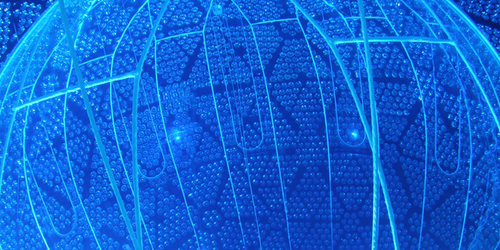Antineutrinos from nuclear reactors detected by water
"The SNO+ collaboration has captured the signal of antineutrinos from nuclear reactors using a water-filled neutrino detector, a first for such a device. The result was selected as Editor’s Suggestion in PRL. LIP researcher Sofia Andringa co-coordinates the SNO+ group that performed the analysis."

SNO+ is a neutrino detector installed at SNOLAB, in a mine in Sudbury (Canada). Today the detector is filled with liquid scintillator and is getting ready for its main goal: to see a so-far-undetected nuclear decay process whose observation would confirm that the neutrino is its own antiparticle.
Back in 2018, the detector contained water - medium the collaboration was using to calibrate detector components and to characterize the radioactive background originating from the fixed elements of the detector (acrylic sphere, support ropes, etc). The researchers took the opportunity to carry out additional measurements before the liquid was switched out. Analyzing the data from the 2018 experiments, the team found a signal ( 3.5-sigma) that matches that expected for antineutrinos coming from nuclear reactors at least 240 km away.
This is the first time such an observation is achieved with this kind of device. The finding offers the possibility of making neutrino detectors from a non-toxic material that is easy to handle and cheap to obtain, key factors for use of the technology in monitoring the world’s nuclear reactors.
LIP researcher Sofia Andringa co-coordinates the SNO+ group that performed the analysis and produced the result now published in Physical Review Letters. The paper was selected as “Editors' Suggestion” and Featured in APS Physics Magazine. The researcher is a member of the LIP Neutrino Physics Group, led by José Maneira and a founding member of the SNO+ Collaboration.
Neutrinos (and antineutrinos) are one of the most abundant particles in the Universe. They are also very hard to detect, as they interact weakly with matter. They are produced in the Sun (and other stars), in the interactions of cosmic particles with the atmosphere, in radioactive decays, and, by human hand, in nuclear reactors and particle accelerators.



